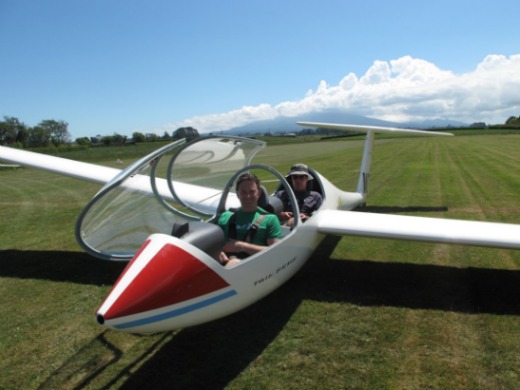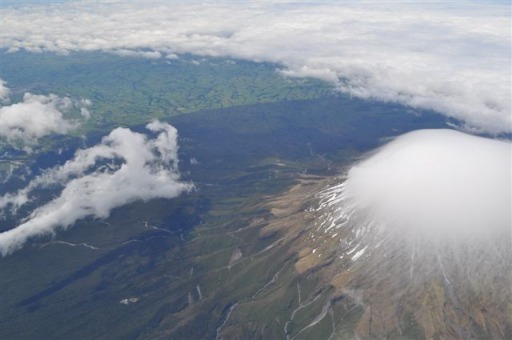|
|
Why Fly Gliders?Why fly gliders?
Here are some answers to common questions. Learning to fly a glider is a challenge ... not so hard it can't be done, but hard enough to be a very satisfying achievement. What is harder is to become really good at it. No glider pilot can sit back and say "there are no more challenges for me". Gliding for many becomes a sport for life. Besides personal achievement gliding opens a new perspective on the natural world ... clouds, winds, birds, the sky and the landscape all take on a new significance. There is also comradeship through pilots sharing similar experiences found nowhere else, and because glider-flying is a co-operative venture shared by volunteers. Is flying a glider difficult? No. You need to be able to use your hands and feet simultaneously to do different things and to interpret your surroundings and react accordingly. The basic skills that we use to drive a car or ride a motor bike demonstrate these skills. How do I get a taste of gliding? A "Trial Flight" is a flight in a two-seat training glider with an instructor designed to introduce you to the joys of gliding. Most clubs and commercial operators will offer Trial Flights. Prices vary depending on method of launch and height of the launch. The Taranaki Gliding Club trial flight price to 2000ft is $170. That entitles the person taking the trial flight to a further three flights at club rates.   Tim Hardwick-Smith and his passenger went on to have a superb flight right up near the mountain. And the day got better! Can I buy a flight as a gift? Yes. The Taranaki Gliding Club offer an option to purchase a gift voucher for a Trial Flight. Many glider pilots were introduced to the sport through a gift. Is there a gliding operation near me? The Taranaki Gliding Club is based at the Stratford Airfield and flies from there at the weekends. Phone (06) 7510824 or email Peter Miller at peterandlynn@xtra.co.nz Our club members are a happy bunch of people with a varied array of skills and a pleasure to be with. How can I learn to fly a glider? Learning to fly a glider starts with a "Trial Flight" - a first flight in a glider to introduce you to gliders and to gliding. After your Trial Flight we can offer a further three flights at club rates or you can join up right away and begin learning a fascinating skill - the art of soaring. As a Qualified Glider Pilot you can fly with other clubs and commercial operations throughout New Zealand at reciprocal rates, experience their local conditions (ridge, wave etc) and get further flight instruction through to advanced cross-country soaring. All training is provided by Gliding New Zealand qualified instructors using the GNZ training syllabus. Is it expensive? In general, gliding is more affordable than you probably think. The learning phase is the most expensive part but once qualified, you can have loads of fun from a flight costing a bit over $100. Once you join our club and get into training the costs will vary with your aptitude. In very general terms most people should budget around $1500-$2000 to get to solo stage, and another $1000 getting to be a Qualified Glider Pilot Once soloed, pilots can fly our club single seat glider and continue to fly the Twin Astir. Sharing a flight with another pilot is great fun and halves the cost. Some will opt to purchase their own glider - maybe buying into a syndicate to share the costs of ownership. Single seat gliders range in cost from a few thousand dollars for an older glider to over a hundred thousand dollars for a state of the art weapon! Whatever the cost, they are all fun to fly! How safe is gliding? Like any aviation activity gliding is not without risks. These risk are minimised through good training and encouragement of a "safety culture" by clubs. New Zealand glider pilots have an enviable safety record. Do you race gliders? Of course! Many pilots enjoy flying gliders in competitions simply as an excuse to get out cross-country flying, some for the thrill of competition. Glider competitions involve flying around pre-determined courses (called tasks) that make the best use of the day's forecast weather. Tasks generally range from 100-300 kms, and can be up to 500kms. Classes are available to accommodate different types of gliders so you don't need to have the most modern sailplane to enjoy flying in competitions. Can power pilots convert to gliders? Glider flying is done under a certification system so it is not a true conversion or rating on your power license. Power pilots though will find little difficulty in adapting to flying gliders. There are a number of differences you will need to adjust to but your instructor(s) will guide you through this. How does a glider fly? An often asked question is how do gliders stay aloft, why don't they just float back to earth? Gliders are always descending - the trick to extended flights is to find air that is moving upwards faster than the glider is descending! There is a vast amount of energy in the air, and gliders pilots can find upward moving currents in excess of 1000 feet per minute ( 5 meters per second) in good conditions. A great deal of the cross-country training focuses on identifying and utilising the different sources of lift available to the cross-country pilot.   A view of the mountain from the Twin Astir at 15000ft. The ragged looking cloud at centre left is rotor cloud. The pilots were flying in strong wave lift of 1000 feet per minute between the rotor cloud and the mountain. How well does a glider perform? One measure of a glider's performance is how far forward it can glide in still air relative to its loss of height. Medium performance gliders typically found at clubs will glide 30kms for each 1000m of height lost. Higher priced higher performance gliders will glide 50-60kms for each 1000m of height lost. In terms of speed, when circling in lift a glider typically flies at 80-100kph. When moving cross-country between sources of lift cruise speeds vary greatly depending on conditions and type of glider but are generally in the range of 100-160kph. Likewise maximum speeds vary considerably from as low as 200kph to in excess of 300kph. Glider flights of over 5 hours duration are not uncommon, and duration records were stopped long ago as they simply became a competition of who could stay awake the longest! Distances flown in gliders are partly related to the glider, and largely related to the skills of the pilot. Many flights of over 1000kms have been flown in New Zealand, and you will often find pilots at a club near you flying 50, 300, and 500km flights as part of an international "badge" program. As for heights, there really is no practical limit. Above 10,000 feet the glider needs to be equipped with oxygen but flights of over 20,000 feet are common in New Zealand. In non-mountain areas flights tend to be at lower heights often operating in a band of around 2-5,000 feet (by international convention altitude is given in feet in aviation). Chris Griffin took one of our gliders to 28000ft, flying out of German Hill. Source: Gliding New Zealand Website (in part adapted to TGC where relevant) Author: Trevor Atkins So, if you are interested in learning to fly contact Taranaki Gliding Club for more information. |
